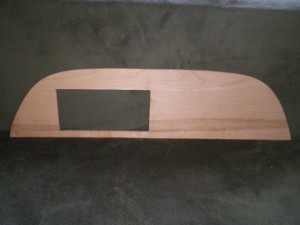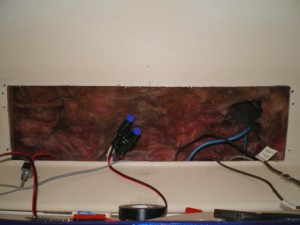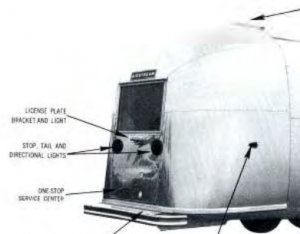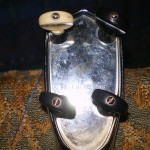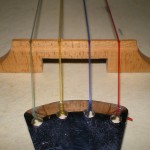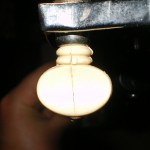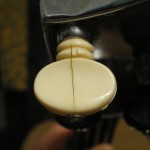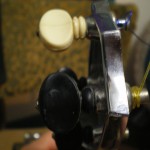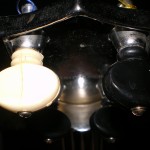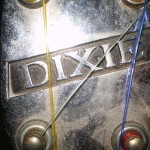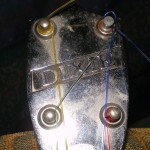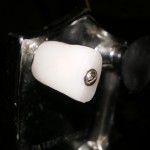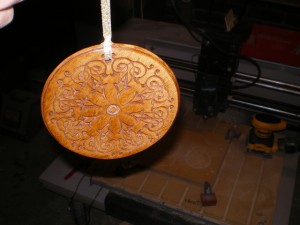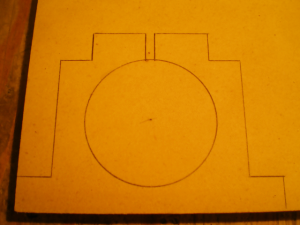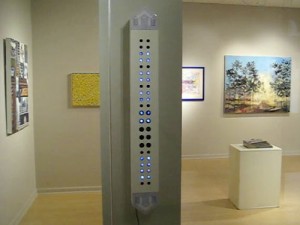Now it was time to replace the old board, with a new one. We decided to make it a little longer and round the corners to match the contoured curve at the top of the trailer. After some measuring and playing around with the design in Rhino, we made a large paper template and used it to mark out the board. Unfortunately the size of the board was to large to fit in the CNC, or I could have made a perfect cut, instead I had to resort to the old scroll saw.
Control Panel – Step 4
June 24th, 2011Control Panel – Step 3
June 23rd, 2011After removing the board that was our old control panel I fished out the shunt wires and tested to make sure they still had a connection to the back of the trailer. Also at the same time I found the brown insulated multi conductor wires for the water tanks sensors.
Control Panel – Step 2
June 21st, 2011Since I wanted to have a current meter on the control panel the first step wast to go through all the wiring in the “One Stop Service Center”.
Control Panel – Step 1
June 20th, 2011For the past few months we have been working on fixing up an older Airstream trailer. Its a 1970 Safari, and came to us in pretty good shape, but was missing one very important item.
The Control Panel duh, dunh, dunh, duh!!!
Dixie Banjolele
June 10th, 2011Fantastic News, I just got a fine gift of one of these beautiful specimens.
Its a small 4 string instrument, built like a banjo, tuned like a ukulele. Its body is cast aluminum and it feels solid and heavy in the hand. It comes with a fantastic sound that projects and really lets you sink down in the details. From what I can gather they were made sometime in the 50s or early 60s 40s & 50s. I have is the “Black” model and its in wonderful shape for its age, if it is really as old as I have read. Only one minor problem at first glance and thats a cracked friction tuner. Apparently this is not the first Dixie to suffer these problems, odd thing is this is the only white peg the others are black and work fine. If you have one of these and you are trying to learn more the Dixie Banjolele Blogspot is the best resource for information on literally the real nuts and bolts that I have found so far.
Here are some close ups of the instrument, the last frame on the right shows off my attempt at a patch for the tuner with a material called ShapeLock. It almost worked, however in my excitement I don’t think I waited quite long enough for it to cure and it slips around the flat of the post.
Christmas Ornaments
December 25th, 2009For Christmas this year I decided to put the machine to work on a production run of unique ornaments for friends and family. The goals of this project where to experiment with some different techniques for using the machine and to test out a few ideas for future projects at the same time. The results were good over all and I learned a few things in the process?
The OZO gets a new Saddle
November 18th, 2009Its time now to build a custom piece of hardware to mount the router to the OZO. Research on the web indicated that people were using MDF for this kind of work. Its dimensionally stable, and easy to machine, though the dust can be kind of toxic. I’ve never worked much with MDF before, preferring real wood or plywood to this glued up particle board.
Being an avid scrounger, however, there where a few pieces laying around the shop. So, I decided to use it as the base material for this build. Since I didn’t have a long enough endmill to make it all the way through the 3/4″ material and didn’t know if the current spindle would be up to the task anyway, I made it the old fashioned way, with hand tools and brute force. First I drew the design in Rhino, then, printed and transferred it to the wood with carbon paper.
A New Spindle
November 18th, 2009For a while now, I have been debating the stoutness of the spindle motor that came with the OZO. It is very quite and high speed but seems to lack enough torque to really bite down and make deeper cuts. The last thing I cut with the machine, oh so long ago now, was thin plywood. I tried to cut the whole thickness in one pass, and while the spindle managed the chore it screeched and whined and complained the whole time. Continuing to use it in that capacity would eventually wear it out and break it. I decided to save it back for finer task, like circuit board milling (probably what it was designed for) and move on to something with a little more guts.
After researching many CNC forums and DIY build write ups I decided on this.

Fake Thermocouple
November 11th, 2009If you are interested in building circuits that will incorporate thermocouples, its nice to have a low millivolt supply for testing and simulating a thermocouple in a heat source. It saves time and energy, keeping you from cranking up the hot plate or the blow torch. Most power supplies will not deliver the low millivolts needed to simulate a thermocouple in a heat source. This device allows you to quickly sweep to a general voltage and then fine tune to a specific value. It uses one 9V battery as a power source and is portable. Voltage ranges on the course dial are from approximately 3mV to 200mV and the fine tune dial will adjust about 4mV around the initial set point.

Light Box
October 26th, 2009A friend and I spent some time a few months ago collaborating on an art piece. His Light Boxes usually consist of some translucent material, film, printed transparency, large prints, envirotex casts etc, that are mounted in or on a box, with a light behind. Sometimes the light moves, sometimes the piece moves, sometimes both are static. We decided to see if we could combine our skills and come up with something a little more dynamic, possibly even something that people viewing the piece could interact with.
